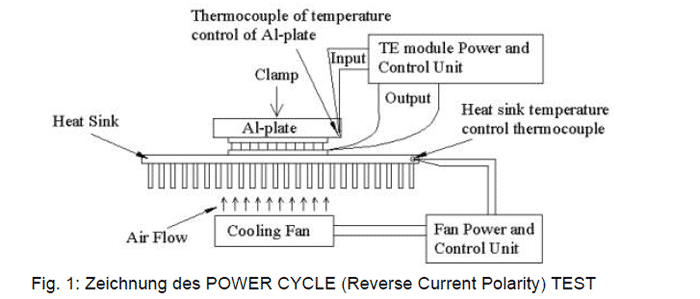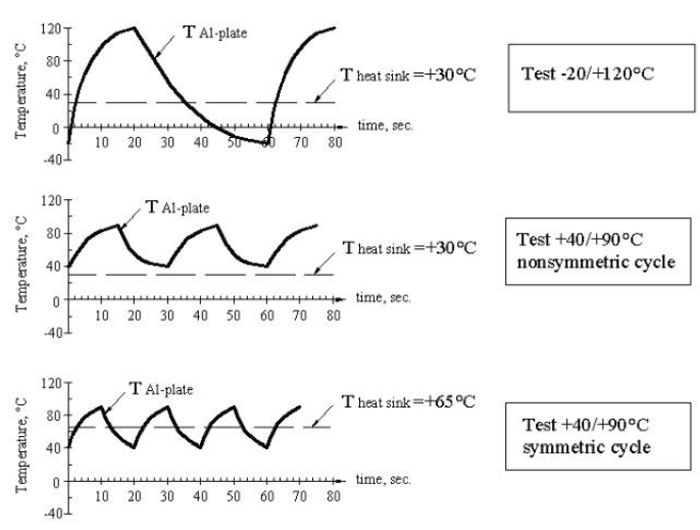Quality and reliability control
Quality of thermoelectric modules and quality control system have always remained among the primary concerns of SCTB NORD company. In the course of long time activity we were making every single effort on the way of permanent quality enhancement approaching superior quality and reliability figures for every thermoelectric element coming from our production line. Below you may get acquainted with complete description of quality and reliability control procedures approved by quality management team for different groups of thermoelectric product.
Every TE module is being thoroughly inspected in regard of quality and reliability data to ensure compliance with modern thermoelectric market requirements.
All produced modules are checked by BASIC SCREENING PROCEDURE consisting of:
1. Visual and Dimensional Inspection
2. Thermal Impulse Testing with the following Ultrasonic Diagnostic of module taking place for detecting latent defects
3. Measurements and examination of module internal resistance (R) and thermoelectric figure of merit (Z).
RELIABILITY TEST is carried out on the regular basis in order to guarantee high reliability features of Peltier elements. Test inspection period does not exceed two (2) years. Besides once changes are made in module assembling technology RELIABILITY TEST is to be also performed. The total content of RELIABILITY TEST in first place is determined by final application of TE cooler and also de revised upon customer's special request. Depending on these two factors we broaden BASIC SCREENING PROCEDURE with additional screening items.
STANDARD MODULES
Quality and reliability control for STADARD TE MODULES is consisted of BASIC SCREENING PROCEDURE and the following contents of RELIABILITY TEST.
Contents of RELIABILITY TEST:
1. Long-term high temperature storage (for example at +85°C).
2. Long-term low temperature storage (for example at -40°C).
3. Symmetric Power Cycling (Reverse Current Polarity) "+40/+90°C"
with period of cycle near 5 min. and number of cycles >2x103 - see Fig.1 and Fig. 2(c).
4. Long-term temperature cycling (for example -40°C/+85°C).
5. Mechanical shock: in accordance with MIL-STD-883, Method 2002.
6. Vibration: in accordance with MIL-STD-883, Method 2007.
7. Shear force: in accordance with MIL-STD-883, Method 2019.
CYCLING APPLICATIONS MODULES
Quality and reliability control of CYCLING APPLICATIONS TE MODULES (M and TMC series) has been developed considering all features of ON/OFF operation mode. Obligatory BASIC SCREENING PROCEDURE can be broadened by additional contents of testing upon customer special request as follows.
Example of additional screening procedure contents:
1. Thermal screening is performed to reject modules with hot or cold spots in solder junctions.
2. Module sorting is performed to receive high cold side temperature uniformity value inside termo module array
under identical conditions of operation.
BASIC SCREENING PROCEDURE is usually followed by contents of RELIABILITY TEST as given below.
Content of RELIABILITY TEST:
1. Long-term high temperature storage (for example at +85°C).
2. Long-term low temperature storage (for example at -40°C).
3. Symmetric Power Cycling (Reverse Current Polarity) "+40/+90°C"
with period of cycle 20-60 sec. and number of cycles >105 - see Fig.1 and Fig.2(c).
4. Long-term temperature cycling (for example -40°C/+85°C).
5. Mechanical shock: in accordance with MIL-STD-883, Method 2002.
6. Vibration: in accordance with MIL-STD-883, Method 2007.
7. Shear force: in accordance with MIL-STD-883, Method 2019.
GENERATING APLPICATION MODULES (TMG-series)
All TMG-series modules are examined by obligatory BASIC SCREENING PROCEDURE and the following contents of RELIABILITY TEST:
Contents of RELIABILITY TESTS:
1. Long-term high temperature storage.
2. Long-term hot side temperature cycling at fixed cold side temperature.
3. Mechanical shock: in accordance with MIL-STD-883, Method 2002.
4. Vibration: in accordance with MIL-STD-883, Method 2007.
5. Shear force: in accordance with MIL-STD-883, Method 2019.
MICROMODULES FOR TELECOMMUNICATION EQUIPMENT APPLICATIONS
Quality and Reliability control for MICROMODULES is based on the Bellcore requirements for TELECOMMUNICATION EQUIPMENT DEVICES. Every produced MICROMODULE is inspected by BASIC SCREENING PROCEDURE and additional screening procedure.
Additional screening procedure contents:
1. Temperature cycling test: -40°C/+85°C.
2. Power cycling (ON/OFF) test: hot side temperature Th=+70°C, I=Imax during "ON" period,
3. Measurements of module internal resistance (R) and figure of merit (Z) values after screening test;
examination of R and Z relative change as a result of the screening test.
BASIC SCREENING PROCEDURE is usually followed by contents of RELIABILITY TEST as given below.
Contents of reliability test:
1. Long-term high temperature storage at +85C.
2. Long-term low temperature storage at -40°C.
3. Long-term temperature cycling: -40°C/+85C.
4. Long-term power cycling (ON/OFF) test: Th=+70°C, I=Imax during "ON" period, I=0 during "OFF" period.
5. Long-term constant current test: Th=+70°C, I=Imax.
6. Mechanical shock: in accordance with MIL-STD-883, Method 2002,
Condition B, a mass is attached to the module cold side to simulate the mass of the temperature-controlled object.
7. Vibration: in accordance with MIL-STD-883, Method 2007, Condition A,
a mass is attached to the module cold side to simulate the mass of the temperature-controlled object.
8. Shear force: in accordance with MIL-STD-883, Method 2019.
Additional reliability test can be performed upon customer request. For example:
1. High temperature storage at +150°C.
2. Temperature cycling: -50°C/+110°C. |



